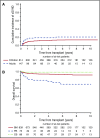Sickle cell disease: an international survey of results of HLA-identical sibling hematopoietic stem cell transplantation
- PMID: 27965196
- PMCID: PMC5356458
- DOI: 10.1182/blood-2016-10-745711
Sickle cell disease: an international survey of results of HLA-identical sibling hematopoietic stem cell transplantation
Abstract
Despite advances in supportive therapy to prevent complications of sickle cell disease (SCD), access to care is not universal. Hematopoietic cell transplantation is, to date, the only curative therapy for SCD, but its application is limited by availability of a suitable HLA-matched donor and lack of awareness of the benefits of transplant. Included in this study are 1000 recipients of HLA-identical sibling transplants performed between 1986 and 2013 and reported to the European Society for Blood and Marrow Transplantation, Eurocord, and the Center for International Blood and Marrow Transplant Research. The primary endpoint was event-free survival, defined as being alive without graft failure; risk factors were studied using a Cox regression models. The median age at transplantation was 9 years, and the median follow-up was longer than 5 years. Most patients received a myeloablative conditioning regimen (n = 873; 87%); the remainder received reduced-intensity conditioning regimens (n = 125; 13%). Bone marrow was the predominant stem cell source (n = 839; 84%); peripheral blood and cord blood progenitors were used in 73 (7%) and 88 (9%) patients, respectively. The 5-year event-free survival and overall survival were 91.4% (95% confidence interval, 89.6%-93.3%) and 92.9% (95% confidence interval, 91.1%-94.6%), respectively. Event-free survival was lower with increasing age at transplantation (hazard ratio [HR], 1.09; P < .001) and higher for transplantations performed after 2006 (HR, 0.95; P = .013). Twenty-three patients experienced graft failure, and 70 patients (7%) died, with the most common cause of death being infection. The excellent outcome of a cohort transplanted over the course of 3 decades confirms the role of HLA-identical sibling transplantation for children and adults with SCD.
© 2017 by The American Society of Hematology.
Figures
Comment in
-
The penny has dropped for sickle cell disease.Blood. 2017 Mar 16;129(11):1412-1413. doi: 10.1182/blood-2016-12-758722. Blood. 2017. PMID: 28302691 No abstract available.
References
-
- National Heart, Lung, and Blood Institute. Evidence-based management of sickle cell disease. Expert Panel Report, 2014. https://www.nhlbi.nih.gov/sites/www.nhlbi.nih.gov/files/sickle-cell-dise.... Accessed 20 September 2016.
-
- Ware RE, Davis BR, Schultz WH, et al. . Hydroxycarbamide versus chronic transfusion for maintenance of transcranial doppler flow velocities in children with sickle cell anaemia-TCD With Transfusions Changing to Hydroxyurea (TWiTCH): a multicentre, open-label, phase 3, non-inferiority trial. Lancet. 2016;387(10019):661-670. - PMC - PubMed
Publication types
MeSH terms
Substances
Grants and funding
LinkOut - more resources
Full Text Sources
Other Literature Sources
Medical
Molecular Biology Databases
Research Materials


